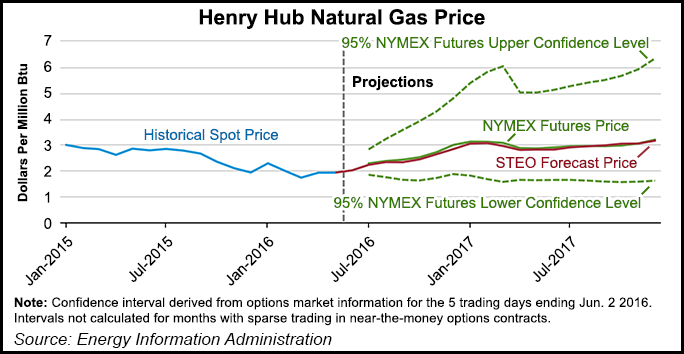Markets | NGI All News Access | NGI The Weekly Gas Market Report
EIA Price Forecast Retreats, Slightly: $2.22/MMBtu This Year, $2.96/MMBtu in 2017
After two months of marketed natural gas production increases that peaked in February, the United States saw a decline in March, the Energy Information Administration (EIA) said.

Total marketed production averaged 79.1 Bcf/d in March, a 1.0% decline from its record high in February (see Daily GPI, June 1), the agency said in its latest Short-Term Energy Outlook (STEO), which was released Tuesday.
“One of the factors contributing to the decline in production was low prices, which fell to an average of $1.73/MMBtu in March before rising slightly in April and May,” EIA said. “Preliminary data indicate production has risen slightly since March, but it remains lower than previous record highs.”
Marketed production had been 78.7 Bcf/d in December and 79.0 Bcf/d in January before peaking at 80.1 Bcf/d in February.
EIA, which last month shined an optimistic light on natural gas prices, backed off just a bit on that forecast, saying it expects Henry Hub prices to average $2.22/MMBtu in 2016 and $2.96/MMBtu in 2017.
“EIA expects natural gas prices will gradually rise through the summer as demand from the electric power sector increases, but forecast prices remain lower than they were last summer,” the agency said.
In its previous STEO, EIA had said it expected Henry Hub prices to average $2.25/MMBtu this year and $3.02/MMBtu in 2017 (see Daily GPI, May 10). EIA’s price forecasts declined steadily throughout 2015 (see Daily GPI, Dec. 8, 2015; Jan. 13, 2015) before firming a bit in January (see Daily GPI, Jan. 25) and then increasing in May.
“Through the 2015-2016 winter, prices remained relatively low because of lower demand as a result of warmer-than-normal temperatures, record inventory levels, and production growth,” EIA said. The agency expects Henry Hub spot prices to remain below $3.00/MMBtu through the end of the year.
Henry Hub prices averaged $1.92/MMBtu last month, unchanged from April, according to the STEO. Natural gas futures prices for September 2016 delivery (for the five-day period ending June 2) averaged $2.42/MMBtu.
Current options and futures prices imply that market participants place the lower and upper bounds for the 95% confidence interval for September 2016 contracts at $1.64/MMBtu and $3.58/MMBtu, respectively. At this time last year, the natural gas futures contract for September 2015 averaged $2.69/MMBtu and the corresponding lower and upper limits of the 95% confidence interval were $1.79/MMBtu and $4.03/MMBtu, EIA said.
Natural gas storage levels remain high. EIA last week reported an injection of 82 Bcf, leaving 2,907 Bcf in natural gas storage, significantly more than a year ago (2,195 Bcf) and the five-year average (2,154 Bcf) (see Daily GPI, June 2). End-of-March working inventories reach 2,492 Bcf, the highest end-of-withdrawal-season level on record. EIA expects gas inventories to be 4,161 Bcf at the end of October, which would be the highest level on record to begin the heating season.
Total natural gas consumption is expected to average 76.6 Bcf/d this year and 77.8 Bcf/d next year, compared with 75.3 Bcf/d in 2015. Gas consumption is expected to increase in the electric power sector by 5.1% this year before declining 1.5% in 2017 as natural gas prices rise and contribute to increasing coal generation. Forecast industrial sector consumption of natural gas increases by 2.7% in 2016 and by 1.7% in 2017 as new fertilizer and chemical projects come online.
EIA expects natural gas exports by pipeline to Mexico will increase because of growing demand from Mexico’s electric power sector and flat natural gas production in Mexico. EIA projects liquefied natural gas (LNG) gross exports will increase to an average of 0.5 Bcf/d in 2016, with the startup of Cheniere’s Sabine Pass LNG liquefaction plant in Louisiana, which sent out its first cargo in February (see Daily GPI,Feb. 24). EIA projects gross LNG exports will average 1.3 Bcf/d in 2017 as Sabine Pass ramps up its capacity.
© 2024 Natural Gas Intelligence. All rights reserved.
ISSN © 1532-1231 | ISSN © 2577-9877 | ISSN © 1532-1266 |
